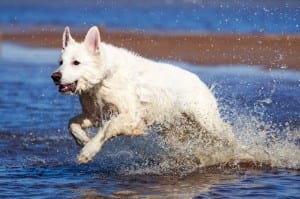 Dogs and children can be a great combination, or an absolute disaster. Small children and dogs should always be supervised, and it is important to read the dog’s body language.
Dogs and children can be a great combination, or an absolute disaster. Small children and dogs should always be supervised, and it is important to read the dog’s body language.
If the dog is licking, pulling its ears back, yawning, or turning its head away, it is probably uncomfortable. Never let a child hug a dog; hugs don’t mean the same thing to dogs as it does to humans, and even though they can be trained to accept it, it doesn’t come naturally.
Every year many children are bit and dogs put down, and the adults say, “It came out of the blue,” or “She was just hugging the neighbor’s dog.” Children don’t know and dogs can’t speak, so it’s the adults’ responsibility to watch over the situation.
That said, some dog breeds are better with children than others. Here are some breeds known to be patient with kids.
Beagles are sturdy and never too tired to play. They’re smart, cheerful, and friendly. They might feel that chasing other pets is a good idea, but other than that they get along with almost everything and everyone.
The Bulldog is loyal, friendly, and docile. Most Bulldogs get along well with children, other dogs, and other types of pets. They’re not exactly bundles of energy, but love to lounge on the sofa while watching TV, reading, or playing video games.
The Bull Terrier was bred to be a companion dog, and is frequently used for kids’ TV shows in many countries. In the USA, the Bull Terrier is probably best known for Target commercials. The average Bull Terrier is friendly, loving, and patient with rambunctious children.
Golden Retrievers are confident, smart, loyal, and kind. A typical Golden Retriever is patient and neither aggressive nor timid. They need a lot of exercise and love to play.
The Labrador Retriever is the most popular dog breed in the USA and many other countries. The Labrador is playful, loving, patient, protective, and reliable.
Newfoundlands are huge and loving. The breed has been nicknamed “Nature’s Babysitter” and is known for being kind, gentle, and patient. The Newfoundland is also very protective when it comes to children.
Poodles are extremely intelligent and gentle. They make great service dogs, and are wonderful, good-natured, and patient companions for children. While poodles require regular grooming, they shed very little.
The Vizsla requires a lot of exercise and makes a great breed for active and energetic families with older children. The average Vizsla is energetic but gentle, obedient, loyal, confident, and smart. It forms close bonds with the family and would be happy to follow the children everywhere.



 Dogs and children can be a great combination, or an absolute disaster. Small children and dogs should always be supervised, and it is important to read the dog’s body language.
Dogs and children can be a great combination, or an absolute disaster. Small children and dogs should always be supervised, and it is important to read the dog’s body language.  Many dogs love to swim, whether it’s in a lake or in a swimming pool, but even if your dog is a natural born swimmer he or she might need a little extra help. Here are some easy tips on staying safe in the pool.
Many dogs love to swim, whether it’s in a lake or in a swimming pool, but even if your dog is a natural born swimmer he or she might need a little extra help. Here are some easy tips on staying safe in the pool.
 Many dogs suffer a fear of fireworks, and with the upcoming holiday it’s extra important to know about this, protect the dogs, and prepare them the best we can. Even a confident dog can be terrified by the loud and unpredictable noises and bright lights.
Many dogs suffer a fear of fireworks, and with the upcoming holiday it’s extra important to know about this, protect the dogs, and prepare them the best we can. Even a confident dog can be terrified by the loud and unpredictable noises and bright lights. Bloat is a dangerous condition caused by a dog or cat eating too fast, sucking in air with their food or water. If this happens, the dog needs to see a vet immediately and might need emergency surgery.
Bloat is a dangerous condition caused by a dog or cat eating too fast, sucking in air with their food or water. If this happens, the dog needs to see a vet immediately and might need emergency surgery. Large parts of the USA anticipate summer with a mix of dread and joy. Summer is great, but would be better without tornadoes and hurricanes. Every year pets are separated from their humans during difficult weather. Some come back, other families keep searching for years with no luck.
Large parts of the USA anticipate summer with a mix of dread and joy. Summer is great, but would be better without tornadoes and hurricanes. Every year pets are separated from their humans during difficult weather. Some come back, other families keep searching for years with no luck. Most dogs are super-curious, and summer invites to investigation. That’s usually not a problem, unless you have one of those dogs that try to eat everything, or play catch with wasps and bees.
Most dogs are super-curious, and summer invites to investigation. That’s usually not a problem, unless you have one of those dogs that try to eat everything, or play catch with wasps and bees.